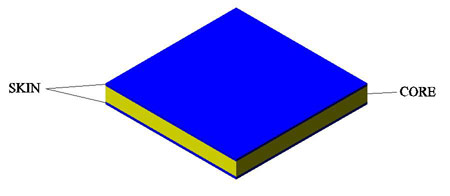What Is a Sandwich Panel
Sandwich panels are a remarkable product because they can act as strong as a solid material, but weigh significantly less. The trend for “stronger-lighter” is becoming increasingly important in the transportation and aerospace industries, and sandwich panels are filling this need.

The common composite sandwich structure is made up of two major elements, the skin and the core. Sandwich panel skins are the outer layers and are constructed out of a variety of materials. Wood, aluminum, and plastics are commonly used. More recently though, advanced composite fibers and resins are being used to create skin material.
The core materials provide many of the panels’ desirable properties and are often composed of wood, foam, and various types of structural honeycomb. Each core has various advantages; for example, balsa wood is a lightweight core, has high strength, but can rot or mold with exposure to moisture. Foam is usually not as stiff as balsa, but is impervious to moisture and has insulating properties. Honeycomb material is strong and stiff, but is often more expensive and can be tricky to fabricate a quality bond between the skins and core.
Overall, the core gives structure to the sandwich, and the skins protect the core. Sandwich panels imitate a solid structure with the fraction of the weight. With the price of oil rising, transportation costs are constantly increasing. There is a direct correlation between the weight of a transportation system and the amount of fuel used. This is resulting in sandwich panels growing in popularity as they help reduce weight, save fuel, and curb emissions.
Sandwich panels are the future of transportation and will be instrumental in saving energy for many years to come.
Related Articles:
What Makes a Sandwich Panel
The Sandwich Panel Core
Thermoplastic vs Thermoset Skins
Learn More About Sandwich Panels:
Composite Reference
Handbook of Sandwich Construction
Sandwich Panel - Wikipedia
Home - Archive - Resources - Contact